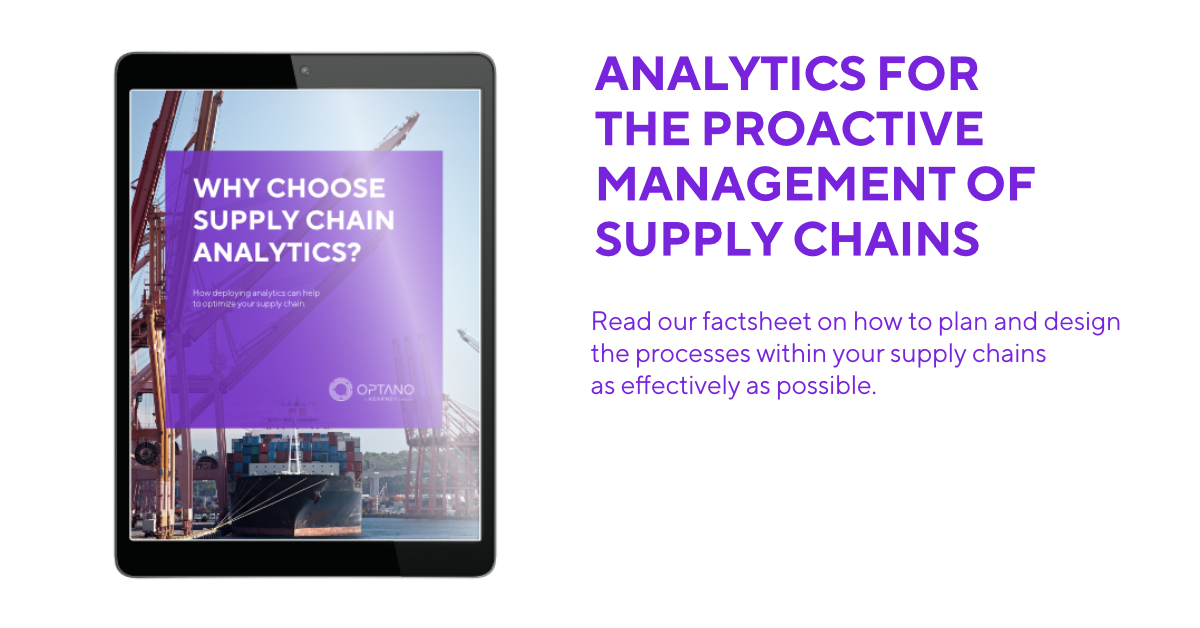How to crack the
bullwhip effect with
Supply Chain Analytics
“Bullwhips are pastoral tools, traditionally used to control livestock in open country. A bullwhip’s length, flexibility, and tapered design allows it to be thrown in such a way that, toward the end of the throw, part of the whip exceeds the speed of sound – thereby creating a small sonic boom.” – Wikipedia
We all remember them: the rows of glaringly empty shelves in the supermarkets caused by the mass panic buying of basic food and hygiene essentials in the early days of the pandemic. Such procurement difficulties are a cause of the “bullwhip effect”.
What is the bullwhip effect?
The bullwhip effect is a phenomenon to describe changes in demand at the end of a supply chain (i.e. the consumer end) which then lead to distortion and fluctuation along the entire chain. Picture it like this: The end consumer holds the whip handle and moves it ever so slightly with his hand. This will create small movement to the parts closest to the handle but increasingly larger, unpredictable movements towards the tip. So, in supply chain terms: a shift in the end consumer’s demand, no matter how small, will amplify up the supply chain like the crack of a whip. This leads to discrepancies at all areas of the supply chain – the stores, logistic providers and manufacturers, right down to the raw material suppliers.
This is exactly what happened during the pandemic. For example, in early 2020, the demand for toilet paper increased by a massive 700%. This panic-buying among consumers led to stores increasing their orders for toilet paper. As a result, manufacturers further up the supply chain had to ramp up production in a desperate attempt to meet the sudden demand. As we know, this was merely a temporary phenomenon and demand dropped as quickly as it had risen and sales fell 33%. A classic example of the bullwhip effect.
However, this is not just caused by panic buying. When a certain product becomes popular, an unforeseen upswing in its demand can lead to bottlenecks and also create a bullwhip effect. Since people had to spend a great deal of time at home during lockdown, they decided to renovate their homes, upgrade their electric household appliances or invest in new home entertainment. The problem for manufacturers and suppliers in the electronics sector was that the concept of “just-in-time” production and delivery, which has prevailed in the markets over the past decades, meant that they could not keep pace with the overwhelming shift in consumer demands.
How to avoid the bullwhip effect?
Yet, whether it’s panic-buying or just a passing fad that triggers the bullwhip effect, the result for businesses is surplus inventory, inefficient production schedules and logistics and ultimately higher costs – both for suppliers and customers – in particular, for the end customer. And because the bullwhip effect tends to take all players unawares, it is essential that effective supply chain management is in place to at least be able to mitigate the impacts of the amplification or, at best, to prevent the whip cracking in the first place. Below are some examples of how this can be achieved:
1. Communication is key!
The more you know what is going on at all areas of the supply chain, the better you can deal with any problems that occur. Communication between all parties is crucial – not just between customers, suppliers and logistic providers, but also between a company’s internal departments – production, purchasing, dispatch, etc. In this way, everybody knows what is going on. Sharing vital information and working together on demand forecasting can help to avoid errors such as ordering too much or too little of a product, for example. This is where it is also essential to analyze consumer behavior: when do customers tend to place more orders for a certain product? Which customer group buys what? Keep abreast of market trends – why is a certain product popular now and will it be as popular six months later? The motto is ”know your customer!” – not just now, but also in the future.
2. Take stock of what you have!
Sound inventory planning is all about ensuring you have the right products in the right quantity in stock. This means analyzing seasonal demands, as well as being able to plan ahead, knowing which products may need to be discontinued and which could be launched. Your inventory needs to be reviewed on a regular basis (is a certain item over-stocked or under-stocked?) and adjusted if necessary. Installing an effective reporting or early-warning system can support you here.
More interesting articles
3. Shorten lead times!
The bullwhip effect can be reduced to a great extent if lead times are reduced. This is simply because the faster products are manufactured, the less likely parts and components are going to accumulate in warehouses. Of course, it also makes sense to have the essential replacement parts in stock to avoid any bottlenecks. Here, it is crucial that your production planning remains transparent so you know exactly how much you need to produce, how many goods you need to order and have in stock.
4. Streamline your supply chain!
The most effective way to implement the advice in point 3 and thus achieve supply chain transparency is by keeping your supply chain short and simple. The longer your supply chain, the more difficult it is to maintain an overview. Focus on finding suppliers who are closer to your business or manufacturing site to ensure faster delivery of the raw materials you need for production and so that you, in turn, can meet your customers’ demands far more easily. Also, having just a few reliable suppliers closer to home instead of miles away in south-east Asia can make for better communication.
5. Digitize your supply chain!
While the afore-mentioned points may appear logical, implementing them often proves difficult since supply chains amass huge amounts of data and there are so many different conflicting goals and constraints to consider. Therefore, it is easy to lose sight of your objectives. This is particularly so when using conventional planning methods, such as spreadsheets. The more complex your supply chain is, the more difficult it is to plan at all, and especially to plan ahead and know which counter-measures need to be taken to stop the bullwhip from spiraling out of control. By using planning software which deploys advanced supply chain analytics you can mitigate the bullwhip effect and drive your company forward with optimized demand planning to meet customers’ demands.
Deploying Supply Chain Analytics successfully- with OPTANO
Advanced software which deploys supply chain analytics can help to predict demand trends and changes and understand them better. Supply chain analytics not only identifies the patterns in demand but also shows their likelihood and effects and – by deploying prescriptive analytics – offers solutions in the form of recommendations on how to act.
An optimization application such as OPTANO provides innovative solutions with which the supply chain planning process can become efficient and flexible. As advanced analytics software, OPTANO goes beyond detailed reporting features by pointing out different alternatives for action. The starting point here is the creation of a mathematical model which maps your entire business processes. Decisions can thus be made with the overall result in mind and not just for one part of the supply chain. By using prescriptive analytics and solver software, thousands of what-if scenarios can be analyzed to help predict and understand customer trends and changes in demand. For example, you can determine how seasonal or weather-related conditions will affect the demand for your product or what would happen if you stopped manufacturing large batches and switched to smaller but more frequent ones, and much more. The result: recommendations for action which maximize supply chain performance with regard to prescribed business objectives and help you to take preventive measures against a bullwhip effect before you even feel the tip of the whip.
If you would like to learn more about how Supply Chain Analytics can help guard against the bullwhip effect, why not download our factsheet “Why Supply Chain Analytics?”
Do you have any further questions on this or any other optimization issue? Contact us today! Our consultants are just a phone call away. Or, if you prefer, e-mail us and we will get back to you without delay.
Softening the blow
The pandemic took us all by surprise at the time and companies were in no way prepared for the changes it brought. What’s more, the last few years have shown us that a pandemic is not the only cause of the bullwhip effect. However, supply chain analysis can definitely help us to react better to uncertainties and changes and thus soften the blow.
Do you already know our factsheet on this topic?

In our factsheet “Why choose supply chain analytics?” we describe the different types of supply chain analytics. You will discover how supply chain analytics works and how it can help to optimize your company’s supply chain.
To obtain our factsheet, all you need to do is enter your contact details in the space below. A pop-up window will then open to download the whitepaper. Please note that by providing us with your email address, you agree that we may contact you on this topic. You may revoke this agreement at any time by contacting [email protected].








